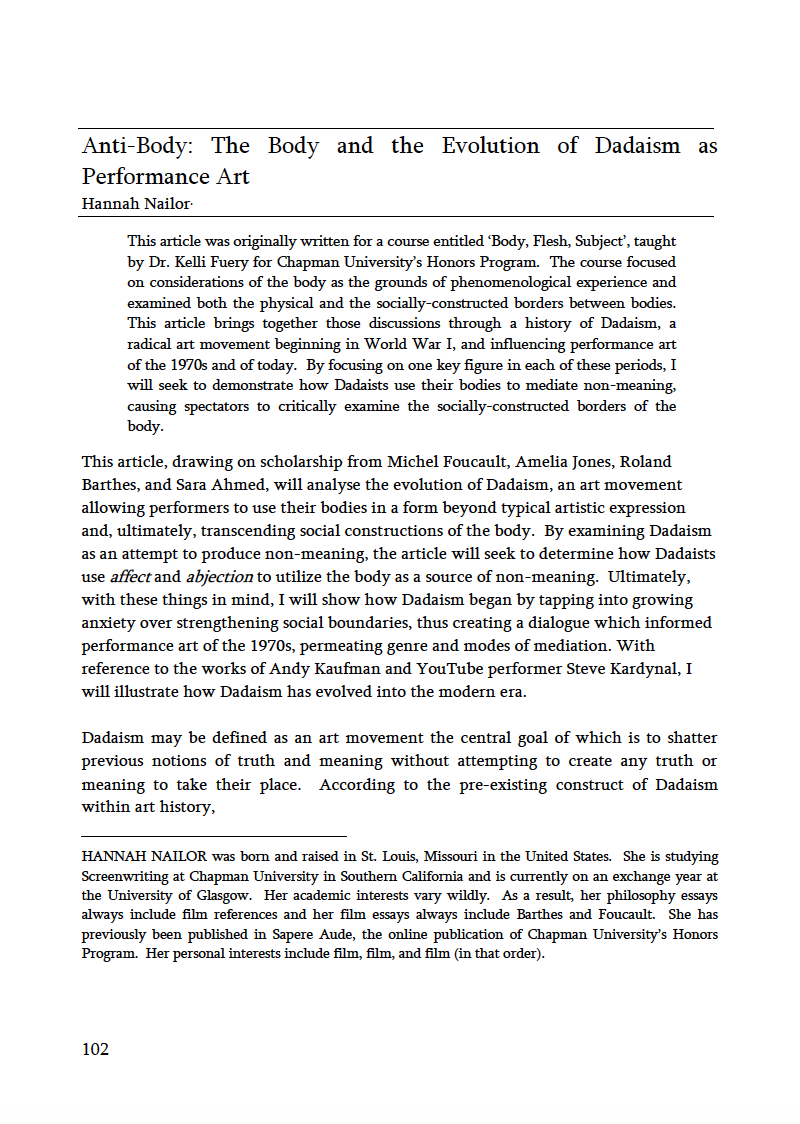Anti-Body
The Body and the Evolution of Dadaism as Performance Art
DOI:
https://doi.org/10.36399/GroundingsUG.8.211Keywords:
Dadaism, Phenomenological Experience, Radical Art, Performance ArtAbstract
This article was originally written for a course entitled ‘Body, Flesh, Subject’, taught by Dr. Kelli Fuery for Chapman University’s Honors Program. The course focused on considerations of the body as the grounds of phenomenological experience and examined both the physical and the socially-constructed borders between bodies. This article brings together those discussions through a history of Dadaism, a radical art movement beginning in World War I, and influencing performance art of the 1970s and of today. By focusing on one key figure in each of these periods, I will seek to demonstrate how Dadaists use their bodies to mediate non-meaning, causing spectators to critically examine the socially-constructed borders of the body.
References
‘Andy Kaufman’, IMDb.com. Available: <http://www.imdb.com/name/nm0001412/?ref_=nv_sr_1> [Accessed 10.12.2013].
‘Baroness von Freytag-Loringhoven working as a model’, photograph, (1915) Interviewmagazine.com. Available:<http://www.interviewmagazine.com/fashion/obsession-baroness-elsa-von-freytag-loringhoven#> [Accessed 10.12.2013].
S. Ahmed, ‘Introduction: Feel Your Way’ in The Cultural Politics of Emotion (Edinburgh, 2004).
R. Barthes, ‘Rhetoric of the Image’ in Image-Music-Text (Glasgow, 1977).
R. Barthes, ‘The Death of the Author’ in Image-Music-Text (Glasgow, 1977).
R. Barthes, Camera Lucida translated by R. Howard (London, 1984).
T. Csordas, ‘Embodiment and Cultural Phenomenology’ in Perspectives on Embodiment: the Intersections of Nature and Culture (London & New York, 2003).
M. Duchamp, Fountain, found art, 1917, 1964. Available: <http://www.tate.org.uk/art/artworks/duchamp-fountain-t07573> [Accessed 10.12.2013].
M. Foucault, Discipline and Punish: The Birth of the Prison (London, 1977).
P. Fuery, ‘The Edge of the Mirror: The Subject and the Other’ in P. Fuery & N. Mansfield (eds.) Cultural Studies and Critical Theory (Oxford, 2000).
R. Hausmann, ABCD, photomontage, 1923-24. Available <http://beautyovertime.blogspot.com/2011/05/abcd-by-raoul-hausmann.html> [Accessed 10.12.2013].
R. Hausmann, Mechanical Head (Spirit of Our Time), assemblage, 1920. Available: <http://www.clg-daumier-martigues.ac-aix-marseille.fr/spip/spip.php?rubrique52> [Accessed 10.12.2013].
J. Hecht, Was This Man a Genius?: Talks with Andy Kaufman (New York, 2001).
Joeyland, ‘The real Andy Kaufman part 2’ (2012) YouTube.com. Available: <http://www.youtube.com/watch?v=OnLJ2MLDJSs> [Accessed 10.12.2013].
A. Jones, Irrational Modernism: A Neurasthenic History of New York Dada (Cambridge, 2004).
S. Kardynal, ‘Miley Cyrus –Wrecking Ball (Chatroulette Version)’ (2013) YouTube.com. Available <http://www.youtube.com/watch?v=W6DmHGYy_xk> [Accessed 10.12.2013].
S. Kardynal, ‘Steve Kardynal is NOT AFRAID!’ (2010) YouTube.com. Available: <https://www.youtube.com/watch?v=lhaCnoY4Z_g> [Accessed 10.12.2013].
J. Kristeva, ‘Approaching Abjection’ in (trans.) L. S. Roudiez, Powers of Horror: An Essay on Abjection (New York, 1982).
B. Massumi, Parables for the Virtual: Movement, Affect, Sensation (Durham, 2002).
W. C. Miller, The Johnny Cash Christmas Special 1979 broadcasted originally on CBS (DVD, 2008).
Saturday Night Live (1975) directed by D. Wilson & A. Brooks, photographs taken from video.
Short R. Short, Dada & Surrealism (New York, 1980).
E. Wissinger, ‘Always on Display: Affective Production in the Modeling Industry’ in P. Clough & J. Halley (eds.), The Affective Turn: Theorizing the Social (Durham & London, 2007).

Downloads
Published
Issue
Section
License
Copyright (c) 2015 Hannah Nailor

This work is licensed under a Creative Commons Attribution 4.0 International License.
The CC BY 4.0 license is a Creative Commons license. This is a non-copyleft free license that is good for art and entertainment works, and educational works. It is compatible with all versions of the GNU GPL; however, like all CC licenses, it should not be used on software. People are free to: Share — copy and redistribute the material in any medium or format; Adapt — remix, transform, and build upon the material for any purpose, even commercially. The licensor cannot revoke these freedoms as long as you follow the license terms. But they must conform to the following terms: Attribution — You must give appropriate credit, provide a link to the license, and indicate if changes were made. You may do so in any reasonable manner, but not in any way that suggests the licensor endorses you or your use. No additional restrictions — You may not apply legal terms or technological measures that legally restrict others from doing anything the license permits.
Please check individual article PDF copies to see if any additional restrictions apply.







